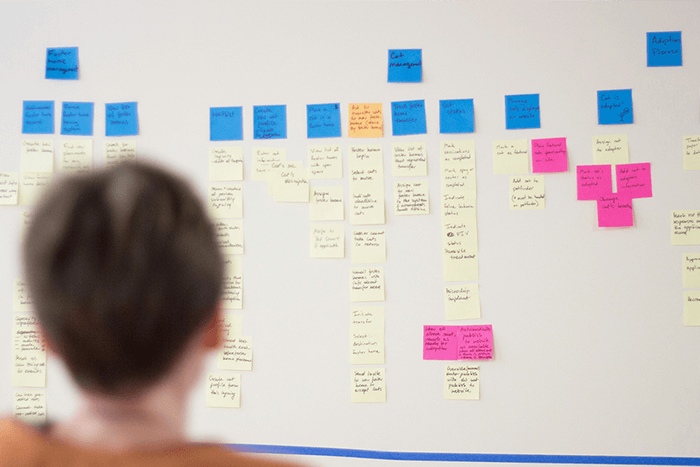
In a previous blog post, Types of UX Research, I discussed how UX research can be classified. I explained qualitative and quantitative, generative and evaluative, formative and summative, and attitudinal and behavioral types of research. Within each of these categories of research, there are several methods that can be used to reach specific project objectives.
It is good to have a range of research methods at one’s disposal, but it’s not necessary to use them all. Particular project needs, the project budget, and the project timeline are all factors that must be taken into account when deciding on which methods to use. Below I discuss specific techniques we use at Caktus to understand users’ thought processes, motivations, and needs.
Interviews
Interviews are a qualitative, attitudinal, generative research method typically used at the onset of a project. They are a great way to gather information ahead of a discovery workshop. They can also be conducted after a discovery workshop to help fill in knowledge gaps discovered during the workshop.
User Interviews
We talk to users to gain insights about who they are; what needs, wants, and pain points they have; in what contexts they operate; what their mental models are, etc. User interviews help us understand the user goals and outcomes that the application we are building must support, and are a basis for developing personas that guide the design and development process. Recruitment of participants for user interviews is done with the help of the client or through a third-party recruiting service that allows us to screen potential participants and select a well-matched target group.
Stakeholder Interviews
While understanding user needs and goals is paramount to requirements gathering, understanding business goals is equally important. Business goals should encompass user goals, but they are voiced from the perspective of the business. We learn about business goals, as well as the client’s perspective on user needs and pain points, by talking to client stakeholders.
Surveys
Surveys are primarily used as a quantitative research method for generative or evaluative purposes. They allow us to collect information from larger groups of respondents and generally result in numeric data. They can also be administered to collect qualitative data through open-ended questions. When used as a generative tool, a survey can inform a discovery workshop or used to fill in knowledge gaps after the workshop. When used as an evaluative tool, a survey can be administered as formative research to evaluate an initial state of an application, or as summative research to assess the final or near-final state of an application.
Card sorting
Card sorting is a qualitative or quantitative (depending on the participant sample size), generative method often used to refine the information architecture of an application or website and to gather insights on which to base navigation design. In this type of study, participants are asked to group items (cards) representing the website’s content into categories that make sense to them. If names of the categories are provided by the researcher, the approach is called closed card sorting. If users are asked not only to categorize items, but also to create and name their own categories, the approach is called open card sorting. A mixed approach (with some categories pre-determined by the researcher, and some left to the participants to create) is called hybrid card sorting. At Caktus, we conduct remote card sorting studies via a third-party platform.
Selecting UX Research Methods for a Project
Interviews, surveys, and card sorting are all methods particularly useful at the onset of a project, although they could also be employed at later stages if clarification of requirements is needed. They help us understand how users think and feel, what they need and want, and why. Based on that understanding, we are better prepared to design a solution that delivers value for the target user segment.
At Caktus, we tailor the selection of research methods to project’s objectives. If understanding users’ needs in quantitative terms is necessary, for example if it is paramount to have confidence that a majority of users display a particular preference or need, a survey is a great tool. If we want to understand why users display a particular preference or need, or how they think about their day-to-day tasks, interviews are the technique of choice. And to understand how users categorize content that they seek or interact with, we conduct card sorting. On any project, best results are obtained with a combination of UX research methods.
Have a project in mind? We can help you decide where to start and what UX research methods to leverage to give your project the best possible starting point.

